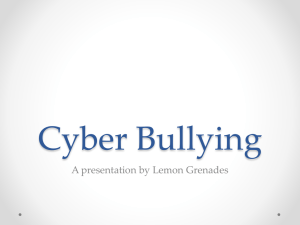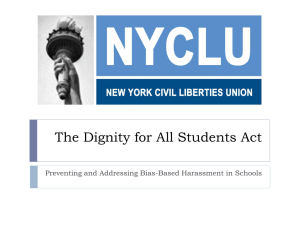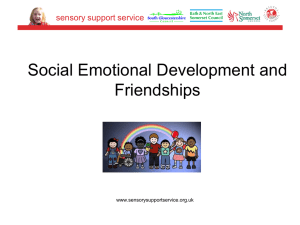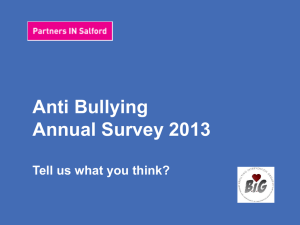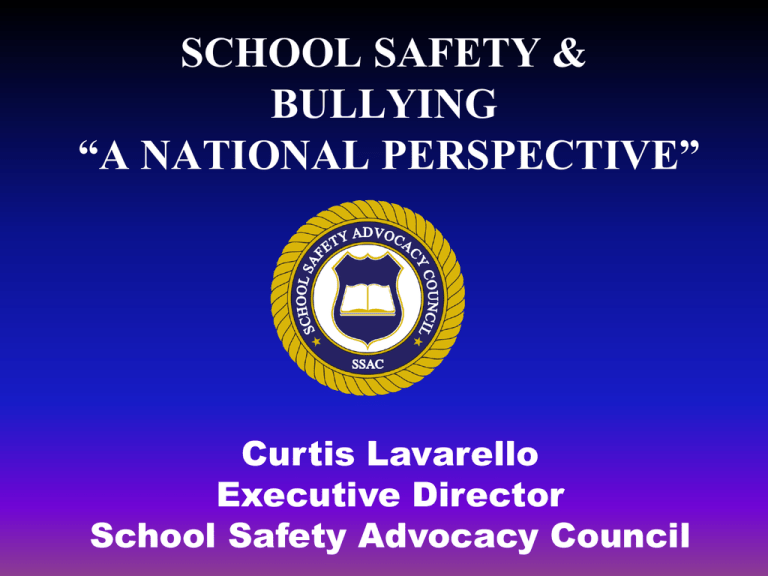
SCHOOL SAFETY &
BULLYING
“A NATIONAL PERSPECTIVE”
Curtis Lavarello
Executive Director
School Safety Advocacy Council
About the School Safety Advocacy Council
• ADVOCACY
• TRAINING
• TECHNICAL ASSISTANCE
About the School Safety Advocacy Council
NATIONAL
RECOGNITION
PROGRAM
CHANGING TIMES ??
HAPPIEST PLACE ON EARTH
EVEN AT THE MOUSE HOUSE
TIMES HAVE CHANGED!
UN-Happiest Place on Earth
TERRORISM
NEW
&
EMERGING
CHEMICAL
THREATS
MAIL
DELIVERY
CHILD
ABDUCTIONS
SCHOOL
TAKEOVER
THREATS
What is SCHOOL
SAFETY?
“Saudis jump aboard
Florida school bus
Police try to determine intent
CNN.com
HEADLINE March 16, 2007
FBI: Foreign extremists sign up to drive
school buses
Washington (AP) – Members of extremist groups have signed up as
school bus drivers in the United States, counterterror officials said
Friday, in a cautionary bulletin to police. An FBI spokesman said
“parents and children have nothing to fear.”
What do our students know???
Evidence – Student Timeline –
Columbine High School
Columbine High School –
Evidence Photo
COMMUNICATION
BETWEEN WHO?
LAW
ENFORCEMENT
PARENTS
SCHOOL
ADMINISTRATION
TEACHERS
CITY / COUNTY
LEADERS
STUDENTS
SCHOOL STAFF
PROBLEMS IN OUR SCHOOLS
Fighting
and Gangs
Alcohol
and Drug
Use
Bullying
Sale of Alcohol
and Drugs
Weapon
Carrying
Schools Deal with a
Host of Issues
Unruly
Students
Sexual Abuse
Truancy
Attacks on
Teachers/Staff
Drop Outs
Domestic
Violence
12
SCHOOL CRIME
GANG
VIOLENCE
FIGHTS
MURDER
WEAPONS
DOMESTIC
VIOLENCE
SEX CRIMES
BURGLARY
THEFT
Who are the stake holders?
Understanding Bullying &
Violence
WEDDING INVITES, VIA THE
WEB?
BIRTH OF A CHILD,
BROADCAST LIVE?
HOSPICE FINAL GOODBY,
BROADCAST LIVE?
Higher Rates of Criminal
Conviction (Ages 15-50)
• Bullies are 1.69 times more likely to be
convicted of a crime between the ages of 15
and 50.
Farrington, Ttofi & Lösel; Criminal Behaviour and Mental Health (2011)
Higher Rates of Violent
Conviction (Ages 15-50)
• Bullies are 1.96 times more likely to be
convicted of a violent crime between the ages
of 15 and 50.
Farrington, Ttofi & Lösel; Criminal Behaviour and Mental Health (2011)
Less Successful Lives (Age 48)
• Bullies are 2.57 times more likely than nonbullies to lead an unsuccessful life at age 48.
Farrington, Ttofi & Lösel; Criminal Behaviour and Mental Health (2011)
Every School Should…
Help to educate faculty, staff & parents about bullying
Have a clear policy against bullying behaviors, and communicate
this policy early and often to students, staff, and parents
Train all staff who interact with students (including bus drivers,
school resource officers, school nurses, and cafeteria workers) on
how to recognize bullying behaviors and intervene effectively to
stop them
Ensure that all staff members take immediate action when bullying
is observed.
Gather data to assess bullying, the level of staff commitment to
address bullying, and parent interest and concerns.
Every Teacher Should…
Initiate discussion with students and parents about expected behavior
before problems arise
Closely supervise your students and be watchful for possible signs of
bullying among students in your classes (sudden changes in behavior, etc)
Take immediate action if you observe or suspect bullying
Integrate bullying prevention into your curriculum in age-appropriate ways
Remember that actions sometimes speak louder than words, and be sure
that you don't inadvertently model bullying behavior
Every Student Should…
Speak up! Step in when other students are being bullied
or tell a teacher what is going on
Make it clear to others that bullying is not okay.
Support bullied students – make them feel like they are
not alone
Help teachers and administrators know what is going on.
Work with them to find solutions.
Source: HRSA Stop Bullying Now!
DIFFERENCES
BULLYING
CYBERBULLYING
• DIRECT
• ANONYMOUS
• Occurs on
school property
• Occurs on OR off
school property
• Poor relationships
with teachers
• Good relationships with
teachers
• Fear retribution
• Fear loss of technology
privileges
Physical: Hitting, Punching &
Shoving
Verbal: Teasing, Name calling &
Gossip
Nonverbal: Use of gestures &
Exclusion
www.stopbullyingnow.hrsa.gov
•
Further under the radar than
bullying
•
Emotional reactions cannot be
determined
{McKenna & Bargh, 2004; Ybarra & Mitchell, 2004}
CYBER BULLYING TYPES
• “Flaming’: Online fights using electronic messages with
angry and vulgar language
• “Harassment”: Repeatedly sending offensive, rude, and
insulting messages
• “Cyber stalking”: Repeatedly sending messages that
include threats of harm or are highly intimidating.
Engaging in other on-line activities that make a person
afraid for his or her own safety
• “Denigration”: ‘Dissing’ someone online. Sending or
posting cruel gossip or rumors about a person to
damage his or her reputation or friendships
CYBER BULLYING TYPES
• “Impersonation”: Pretending to be someone else and
sending or posting material online that makes that person
look bad, gets that person in trouble or danger, or damages
that person’s reputation or friendships
• “Outing and Trickery”: Sharing someone’s secret or
embarrassing information online. Tricking someone into
revealing secrets or embarrassing information which is
then shared online
• “Exclusion”: Intentionally excluding someone from an
on-line group, like a ‘buddy list’
{Nancy Willard, M.S., J.D., Director of the Center for Safe and Responsible
Internet Use}
What is Social Networking?
Allows users to:
Create web pages that provide information about
themselves
Available to be viewed by other users
Allows searches and communication with
other users
Over 300 different social networking sites
Popular Social Networking
Websites
Myspace.com
Facebook.com
YouTube.com
Twitter.com
Tumbler.com
Imgfave.com
PS3
Xbox Live
Moshimonsters.com
Facebook Statistics
People on Facebook
More than 500 million active users
50% of our active users log on to Facebook in any given day
Average user has 130 friends
People spend over 700 billion minutes per month on Facebook
Activity on Facebook
There are over 900 million objects that people interact with (pages, groups, events and community pages)
Average user is connected to 80 community pages, groups and events
Average user creates 90 pieces of content each month
More than 30 billion pieces of content (web links, news stories, blog posts, notes, photo albums, etc.) shared each month.
Global Reach
More than 70 translations available on the site
About 70% of Facebook users are outside the United States
Over 300,000 users helped translate the site through the translations application
Mobile
There are more than 150 million active users currently accessing Facebook through their mobile devices.
People that use Facebook on their mobile devices are twice as active on Facebook than non-mobile users.
There are more than 200 mobile operators in 60 countries working to deploy and promote Facebook mobile products
More than 500 million active users in July 2010, which is about one person for every fourteen in the world.
Facebook was then opened on September 26, 2006, to everyone of ages 13 and older with a valid e-mail address
In June 2010, an online marketplace for trading private company stock reflected a valuation of $11.5 billion.
Cyberbullying Stats
42% of kids have been bullied while online. 1 in 4 have had it happen
more than once.
35% of kids have been threatened online. Nearly 1 in 5 have had it
happen more than once.
21% of kids have received mean or threatening e-mail or other messages.
58% of kids admit someone has said mean or hurtful things to them
online. More than 4 out of 10 say it has happened more than once.
53% of kids admit having said something mean or hurtful to another
person online. More than 1 in 3 have done it more than once.
58% have not told their parents or an adult about something mean
or hurtful that happened to them online.
Source:
www.cyberbullying.us
CYBER BULLYING
LEGAL ISSUES
Who May Be Involved:
School Counselor
School Limits:
Schools have policies against
bullying
Principal
Resource Officer
Police
Attorney (School or Private)
Superintendent
Internet Service Provider
Civil Law Limits:
Cyber bullying may also meet
standards for ‘institutional torts’
(wrongdoings)
Defamation
Material that Constitutes an
Invasion of Privacy
(1st Amendment)
General (Willard, 2005)
Intentional Infliction of
Emotional Distress
CYBER BULLYING
LEGAL ISSUES
Criminal Law Limits
The following kinds of speech can lead to arrest &
prosecution:
•
Making threats of violence to people or their
property
•
Engaging in coercion
•
Making obscene or harassing phone calls
•
Harassment or stalking
•
Hate or bias crimes
•
Creating or sending sexually explicit images of
teens
•
Sexual exploitation
•
Taking a photo of someone in place where privacy
expected
General (Willard, 2005)
CYBER BULLYING
LEGAL ISSUES
‘Educator’s Guide To Cyber bullying:
Addressing the Harm of On-line Social Cruelty’
(Nancy Willard, 2005)
Law Enforcement should be contacted if
educator becomes aware of:
• Death threats or threats of other forms of violence to a
person or property
• Excessive intimidation or extortion
• Threats or intimidation that involve any form of bias or
discrimination
• Any evidence of sexual exploitation
CONCLUDING THOUGHTS
A Need For:
A better understanding of what bullying, cyber-bullying is and its connection to school
violence
Addressing appropriate computer protocol and specifically cyber bullying via the
schools’ clearly defined and systematically implemented policy so that schools can
provide intervention even in instances that occur outside of school
Clearer delineation of school responsibility in responding to incidents, especially off
school grounds
Clearer school policies and action plans; increased continuity in implementing school
responses
Increased assessment of incidents and those involved
Systematic, therapeutic responses, not isolated disciplinary reactions
Integration of educational, psycho-social interventions
Inclusion of prevention measures that are comprehensive and systemic in approach
Communication among students, counselors, teachers, administrators, parents &
community
Change needs to come from all levels and grades:
Individual
Classroom
School culture
Victimization often occurs with both the person being cyber bullied and the cyber bully
www.SCHOOLSAFETY911.org
OCT 25-26, 2013
WATERFRONT PLACE HOTEL
MORGANTOWN, WV
FEB 27 – MARCH 1, 2013
ROSIN CENTRE HOTEL
ORLANDO, FL
JULY 22-26,
2013
RED ROCK
RESORT
LAS VEGAS,
NEVADA
Thank
You
CONTACT
Curtis Lavarello
Curt Lavarello
RESOURCER@AOL.CO
MRESOURCER@AOL.COM
941-232-4633
(941)
232-4633 – Cell


